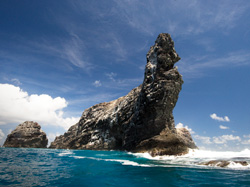1. Microplastic Discovered in the Deep, Open Ocean
 Our oceans have long been considered a major sink for
plastic debris. Scientists at the National Oceanography Centre (NOC) will soon
begin analyzing over twenty years of sample data collected using sediment traps
from an ocean depth of 3,000 meters to gain a deeper understanding of
microplastic accumulation in the deep sea. Their findings will be used to
generate ocean model scenarios to reveal deeper insight into how microplastic
pollution impacts the health of both humans and marine ecosystems around the world. Read more here...
Our oceans have long been considered a major sink for
plastic debris. Scientists at the National Oceanography Centre (NOC) will soon
begin analyzing over twenty years of sample data collected using sediment traps
from an ocean depth of 3,000 meters to gain a deeper understanding of
microplastic accumulation in the deep sea. Their findings will be used to
generate ocean model scenarios to reveal deeper insight into how microplastic
pollution impacts the health of both humans and marine ecosystems around the world. Read more here...
Photo Credit: National Oceanography Center
-----------------------------------------------
2. The Scientific Southern Elephant Seals!
The Southern Elephant Seal is doing what scientists can’t,
which is studying the dynamics of ocean currents during the Antarctican winter.
The temporary data monitors attached to the heads of the seals studies the
Antarctic Polynya System, a patch of ocean that is surrounded by shelf ice and
fails to freeze. The study, published in Nature
Communications, shows that during this critical time for dense shelf water
formation, fresh water is melting from southern sea ice and significantly
reducing ocean density in the area. Changes to this global ocean overturning
system, as a result of a warming climate, could potentially lead to the
collapse of the Antarctic bottom water formation. Read more...
-----------------------------------------------
3. Greenland Sharks May Live for 400 Years
According to Science magazine,
the Greenland Shark has now replaced the Bowhead Whale as the longest living
vertebrate on Earth. The gray colored shark grows only one centimeter per year
and can live for up to 400 years. An international team of biologists and
physicists used a complex system involving chemical tests, growth measurements,
and mathematical models using the lenses of the sharks’ eyes to determine their
age. They believe the sharks’ slowed metabolism, due to their cold and deep
water habitat, contributes to the sharks’ long lifespan. Read more...
-----------------------------------------------
4. Cannibal Sharks?!
Read more...
-----------------------------------------------
Photo credit: Wayne Levin
-----------------------------------------------
6. America's First Offshore Wind Farm is Powered On!
-----------------------------------------------
7. Sustainable Cinderblocks
The sustainably minded company, ByFusion, has sleuthed out
an innovative way to convert the oceans’ plastic pollution into LEED certified
cinderblocks. The blocks use 95% less Greenhouse Gas Emissions will preserving
the world’s dwindling sand deposits used to make regular concrete blocks. Read more...
Photo Credit: ByFusion
-----------------------------------------------
Be sure to "LIKE" http://facebook.com/SeaSave to ensure our "Week in Review" is delivered to your newsfeed every Thursday.
Sea Save Foundation is committed to raising awareness of marine conservation. The Week in Review is a team effort produced by the Sea Save staff to provide a weekly summary of the latest in marine research, policy, and news.





